Search engine optimization, or SEO, is incredibly important for marketers. When you optimize your web pages — including your blog posts — you're making your website more visible to people who are entering keywords associated with your product or service via search engines like Google.
But does your blog content really help your business organically rank on search engines?
Although it's clear blog content does contribute to your SEO, Google's copious algorithm updates can make this tricky. And today's SEO best practices are all about relevancy and intent.
So, when it comes to your blog, how do you know what matters and what doesn't? What are today's blog ranking tactics, and what's considered "old-school"? How can you keep it all straight?
Keep reading — I'll explain.
Simplifying SEO
Confusion is a common issue facing digital content marketers — and we want to help. In this post, we'll cover how to optimize your blog posts for the keywords you care about, along with a few other optimization tactics you should keep in mind.
And since SEO can be confusing, listen to HubSpot's Matt Barby and Victor Pan simplify a few things in this podcast episode:
Additionally, there are some other ways you can simplify SEO in terms of your business's blog. Along with the blog SEO tips we're going to review momentarily, consider the following.
If you're a HubSpot customer, look at specific SEO optimization tips for your individual blog posts. You can do this by clicking the bar graph icon on the far left side of your blog editor when you're working on the post to access the SEO Optimization screen. If you're not a HubSpot customer, use these tips as a checklist as you blog:
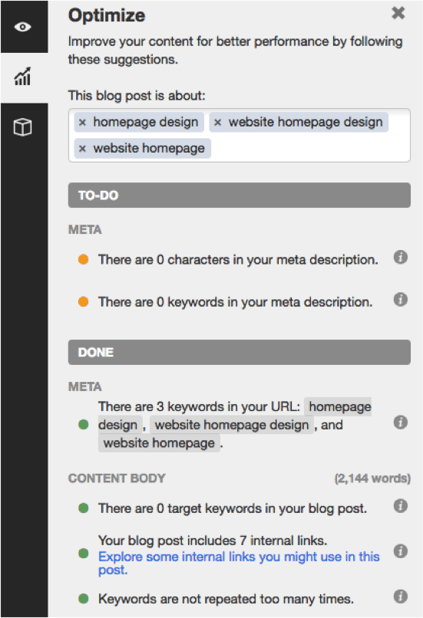
Now, let's take a look at the 12 blog SEO tips that you can take advantage of to enhance your content's searchability.
Note: This list doesn't cover every SEO rule under the sun. Rather, the following 12 SEO tips are the on-page factors to get you started with an SEO strategy for your blog.
1. Focus on 1–2 long-tail keywords that match the intent of your target reader.
Optimizing your blog posts for keywords is not about incorporating as many keywords into your posts as possible. Nowadays, this actually hurts your SEO because search engines consider this keyword stuffing (i.e., including keywords as much as possible with the sole purpose of ranking highly in organic search).
It also doesn't make for a good reader experience — a ranking factor that search engines now prioritize to ensure you're answering the intent of your visitors. Therefore, you should use keywords in your content in a way that doesn't feel unnatural or forced.
A good rule of thumb is to focus on one or two long-tail keywords per blog post. While you can use more than one keyword in a single post, keep the focus of the post narrow enough to allow you to spend time optimizing for just one or two keywords.
You may be wondering: Why long-tail keywords?
These longer, often question-based keywords keep your post focused on the specific goals of your audience. For example, the long-tail keyword "how to write a blog post" is much more impactful in terms of SEO than the short keyword "blog post".
Website visitors searching long-tail keywords are more likely to read the whole post and then seek more information from you. In other words, they'll help you generate right type of traffic — visitors who convert.
2. Include these 1–2 keywords in specific parts of your post.
Now that you've got your one or two keywords, it's time to incorporate them in your blog post. Where are the best parts of your posts to include these terms so you rank high in search results?
There are four essential places where you should try to include your keywords: title tag, headers & body, URL, and meta description.
Title Tag
The title (i.e., headline) of your blog post will be a search engine's and reader's first step in determining the relevancy of your content. So, including a keyword here is vital. Google calls this the "title tag" in a search result.
Be sure to include your keyword within the first 60 characters of your title, which is just about where Google cuts titles off on the SERP. Technically, Google measures by pixel width, not character count, and it recently increased the pixel width for organic search results from approximately 500 pixels to 600 pixels, which translates to around 60 characters.
Long title tag? When you have a lengthy headline, it's a good idea to get your keyword in the beginning since it might get cut off in SERPs toward the end, which can take a toll on your post's perceived relevancy.
In the example below, we had a long title that went over 65 characters, so we front-loaded it with the keyword for which we were trying to rank: "on-page SEO."

Headers & Body
Mention your keyword at a normal cadence throughout the body of your post and in the headers. That means including your keywords in your copy, but only in a natural, reader-friendly way. Don't go overboard at the risk of being penalized for keyword stuffing.
Before you start writing a new blog post, you'll probably think about how to incorporate your keywords into your post. That's a smart idea, but it shouldn't be your only focus, nor even your primary focus.
Whenever you create content, your primary focus should be on what matters to your audience, not how many times you can include a keyword or keyword phrase in that content. Focus on being helpful and answering whatever question your customer might've asked to arrive on your post. Do that, and you'll usually find you naturally optimize for important keywords, anyway.
URL
Search engines also look to your URL to figure out what your post is about, and it's one of the first things it'll crawl on a page. You have a huge opportunity to optimize your URLs on every post you publish, as every post lives on its unique URL — so make sure you include your one to two keywords in it.
In the example below, we created the URL using the long-tail keyword for which we were trying to rank: "email marketing examples."

Meta Description
Your meta description is meant to give search engines and readers information about your blog post's content. Meaning, you must use your long-tail term so Google and your audience are clear on your post's content.
At the same time, keep in mind the copy matters a great deal for click-through rates because it satisfies certain readers' intent — the more engaging, the better.
3. Make sure your blog is mobile-friendly (or has a responsive design).
Did you know more people use a search engine from their mobile phones than from a computer?
And for all those valuable search queries being done on mobile, Google displays the mobile-friendly results first. This is yet another example of Google heavily favoring mobile-friendly websites — which has been true ever since the company updated its Penguin algorithm in April 2015.
(HubSpot customers: Breathe easy. All content created on HubSpot's platform is automatically responsive to mobile devices.)
So, how do you make your blog mobile-friendly? By using responsive design. Websites that are responsive to mobile allow blog pages to have just one URL instead of two — one for desktop and one for mobile, respectively. This helps your post's SEO because any inbound links that come back to your site won't be divided between the separate URLs.
As a result, you'll centralize the SEO power you gain from these links, helping Google more easily recognize your post's value and rank it accordingly.
Pro tip: What search engines value is constantly changing. Be sure you're keeping on top of these changes by subscribing to Google's official blog.
4. Optimize the meta description and use all the space.
To review, a meta description is the additional text that appears in SERPs that lets readers know what the link is about. The meta description gives searchers information they need to determine whether or not your content is what they're looking for and ultimately helps them decide if they'll click or not.
The maximum length of this meta description is greater than it once was — now around 300 characters — suggesting it wants to give readers more insight into what each result will give them.
So, in addition to being reader-friendly (compelling and relevant), your meta description should include the long-tail keyword for which you are trying to rank.
In the following example, I searched for "email newsletter examples."

The term is bolded in the meta description, helping readers make the connection between the intent of their search term and this result. You'll also see the term "E-Newsletter" bolded, indicating that Google knows there's a semantic connection between "email newsletter" and "E-Newsletter."
Note: Nowadays, it's not guaranteed that your meta description is always pulled into SERPs as it once was. As you can see in the above image, Google pulls in other parts of your blog post that includes the keywords searched, presumably to give searchers optimal context around how the result matches their specific query.
Let me show you another example. Below is an example of two different search queries delivering two different snippets of text on Google SERPs. The first is a result of the query "no index no follow," and pulls in the original meta description:

The second is a result of the query "noindex nofollow," and pulls in the first instance of these specific keywords coming up in the body of the blog post:

While there's not much you can do to influence what text gets pulled in, you should continue to optimize this metadata, as well as your post, so search engines display the best content from the article. By creating reader-friendly content with natural keyword inclusion, you'll make it easier for Google to prove your post's relevancy in SERPs for you.
5. Optimize your images with image alt text.
Blog posts shouldn't only contain text — they should also include images that help explain and support your content. However, search engines don't simply look for images. Rather, they look for images with image alt text. Meaning, to ensure your images benefit your blog's SEO, you'll need to ensure you include image alt text.
You may be wondering why this is. Since search engines can't "see" images the same way humans can, an image's alt text tells the search engine what an image is about. This ultimately helps those images rank in the search engine's images results page.
Image alt text also makes for better user experience (UX) — it displays inside the image container when an image can't be found or displayed and can improve accessibility for people with poor vision who are using screen readers. Technically, alt text is an attribute that can be added to an image tag in HTML.
Here's what a complete image tag might look like (bolding added for emphasis):
<img class="wt-blog__normal-image" src="image.jpg" alt="image-description" title="image tooltip">
When you incorporate image alt text, an image's name in your blog may go from something like, "IMG23940" to something accurate and descriptive such as "puppies playing in a basket."

Image alt text should be descriptive in a helpful way — meaning, it should provide the search engine with context to index the image if it's in a blog article related to a similar topic.
To provide more context, here's a list of things to be sure you keep in mind when creating alt text for your blog's images:
- Describe the image
- Leave out "image of... "— begin the image description, instead
- Be specific in your description
- Keep it under 125 characters
- Use your keywords (but avoid keyword stuffing)
HubSpot customers: The SEO Panel will recognize whether or not you have optimized your images. Though these elements are not as important as some other optimizations, they're still necessary (not to mention, easy to add).

6. Don't use too many similar topic tags.
Topic tags can help organize your blog content, but if you overuse them, they can actually be harmful. If you have too many similar tags, you may get penalized by search engines for having duplicate content.
Think of it this way, when you create a topic tag (which is simple if you're a HubSpot user, as seen here), you also create a new site page where the content from those topic tags will appear. If you use too many similar tags for the same content, it appears to search engines as if you're showing the content multiple times throughout your website. For example, topic tags like "blogging," "blog," and "blog posts" are too similar to one another to be used on the same post.
If you're worried that your current blog posts have too many similar tags, take some time to clean them up. Choose about 15–25 topic tags that you think are important to your blog and that aren't too similar to one another. Then only tag your posts with those keywords. That way, you won't have to worry about duplicate content.
7. Use URL structures that help your visitors.
The URL structure of your web pages (which are different from the specific URLs of your posts) should make it easy for your visitors to understand the structure of your website and the content they're about to see. Search engines favor web page URLs that make it easier for them and website visitors to understand the content on the page.
This differentiation is baked into the HubSpot blogs' respective URL structures. If I decided to go to the Marketing section from this main page, I would be taken to the URL http://blog.hubspot.com/marketing.
If we want to read the Sales section, all we have to do is change where it says "marketing" in the URL to "sales": http://blog.hubspot.com/sales. This URL structure helps me understand that "/marketing" and "/sales" are smaller sections — called subdirectories — within the larger blog.
What if there's a specific article we want to read, such as "How to Do Keyword Research: A Beginner's Guide"? Its URL structure — http://blog.hubspot.com/marketing/how-to-do-keyword-research-ht — denotes that it's an article from the Marketing section of the blog.
In this way, URL structure acts as a categorization system for readers, letting them know where they are on the website and how to access new site pages. Search engines appreciate this, as it makes it easier for them to identify exactly what information searchers will access on different parts of your blog or website.
8. Link internally when possible.
Inbound links to your content help show search engines the validity or relevancy of your content. The same goes for linking internally to other pages on your website. If you've written about a topic that's mentioned in your blog post on another blog post, ebook, or web page, it's a best practice to link to that page.
(You might've noticed that I've been doing that from time to time throughout this blog post when I think it's helpful for our readers.) Not only will internal linking help keep visitors on your website, but it also surfaces your other relevant and authoritative pages to search engines.
HubSpot customers: The SEO Panel automatically suggests linking to other internal resources on your website.
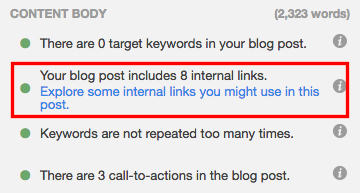
You can think of this as solving for your SEO while also helping your visitors get more information from your content.
9. Use Google's Search Console.
Google's free Search Console contains a section called the Search Analytics Report. This report helps you analyze clicks from Google Search — it's useful to determine which keywords people are using to find your blog content. You can also learn how to use Google Search Console by reading this blog post written by my colleague Matthew Barby, and by checking out Google's official support page.
If you're interested in optimizing your best-performing older blog posts for traffic and leads like we've been doing since 2015, this tool can help identify low-hanging fruit.
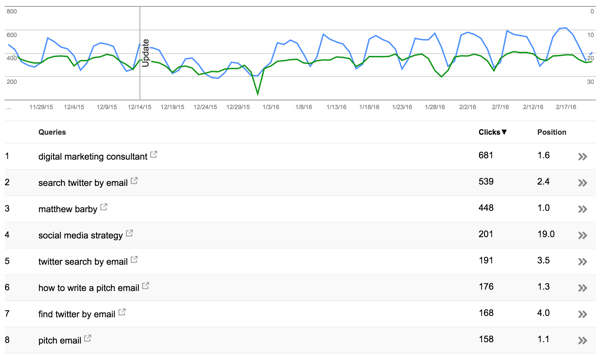
Remember, many content marketers struggle with optimizing their blog posts for search. The truth is, your blog posts won't start ranking immediately. It takes time to build up search authority.
But, when you publish blog posts frequently and consistently optimize them for search while maintaining an intent-based reader experience, you'll reap the rewards in the form of traffic and leads long-term.
10. Use topic clusters.
The way most blogs are currently structured (including our own blogs, until very recently), bloggers and SEOs have worked to create individual blog posts that rank for specific keywords.
This makes things unorganized and difficult for blog visitors to find the exact information they need. It also results in your URLs competing against one another in search engine rankings when you produce multiple blog posts about similar topics.
Here's what our blog architecture used to look like using this old playbook:
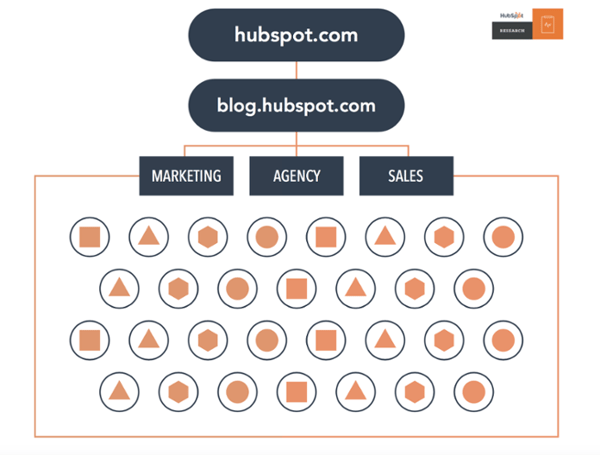
Now, in order to rank in search and best answer the new types of queries searchers are submitting, the solution is the topic cluster model.
For this model to work, choose the broad topics for which you want to rank. Then, create content based on specific keywords related to that topic that all link to each other to establish broader search engine authority.
This is what our blog infrastructure looks like now, with the topic cluster model. Specific topics are surrounded by blog posts related to the greater topic, connected to other URLs in the cluster via hyperlinks:
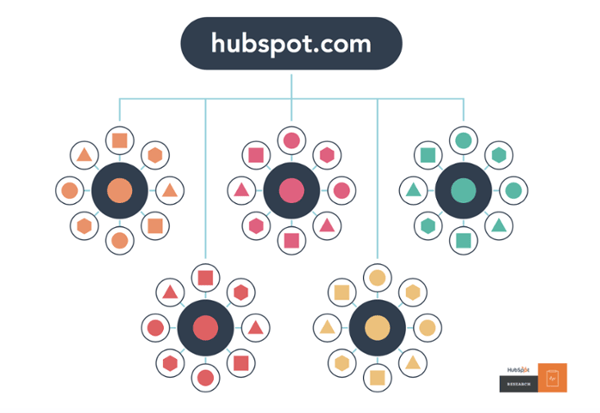
This model uses a more deliberate site architecture to organize and link URLs together to help more pages on your site rank in Google — and to help searchers find information on your site more easily. This architecture consists of three components — pillar content, cluster content, and hyperlinks:
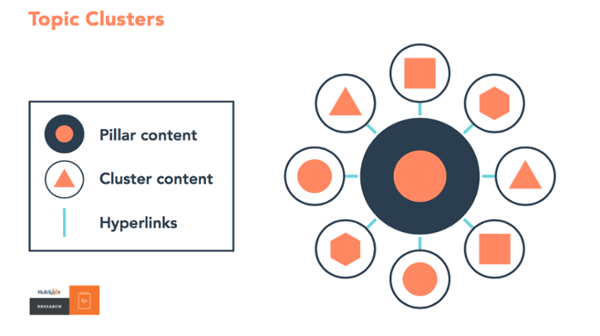
We know this is a fairly new concept, so for more details, check out our research on the topic, take our SEO training or the video below.
11. Continually create and publish evergreen content.
When planning and writing your blog articles, ensure it's evergreen content. Meaning, the content is about topics that are sure to remain relevant and valuable over a long period of time (with only minor changes or updates). Let's look at a few reasons why evergreen content is so important:
- It'll help you rank over time, not just the near future.
- It contributes to steady amounts of traffic coming to your blog (and website) long after it's date of publication.
- It'll help you generate leads over time as a result of the traffic it continually generates.
All blog content — whether it's a long-form article, how-to guide, FAQ, tutorial, and so on — should be evergreen. Even the images you use in these posts should be evergreen. Check out this blog post for some examples of and ideas for evergreen content on your blog.
12. Repurpose or update your current content and remove outdated content.
To improve your SEO, you may assume you need to create new blog content. Although that's partially true, you should also focus a great deal of your time and energy on your existing blog content. Specifically, repurposing and updating your current content, as well as removing your outdated content.
This is because it takes a lot longer for a completely new piece of content to settle on the search engine results page (SERP) and gain authority, whereas you could update a piece of content and reap the benefits fairly immediately in comparison.
Not only will your updated content rank on the SERP faster, improving your number of visitors and leads, it also takes a lot less time and fewer resources to update an existing piece of content rather than create a brand new article.
Additionally, updating and repurposing some of your most successful pieces of content extends it's lifespan so you can achieve the best results over a longer period of time (especially if it's evergreen content).
The final part to this entails removing your outdated content that's no longer relevant to your audience. Although your goal is to ensure your content is evergreen, some of it is bound to become outdated over time. This includes statistics, product information (if you have any listed in your blogs — as your products and business evolve), or information that changes across your industry over time.
Your rule of thumb should be if it no longer fits, and updating it doesn't make sense or work for the situation, simply remove it.
Optimize Your Blog Content
We don't expect you to incorporate each of these SEO best practices into your content strategy right away. But, as your website grows, so should your goals on search engines. Then you'll be able to do some link building to get other websites to link back to your blog.
Once you identify the goals and intent of your ideal readers, you'll be on track to deliver content organically that is always relevant to them.
from Marketing https://ift.tt/2Dw6E8W

No comments:
Post a Comment